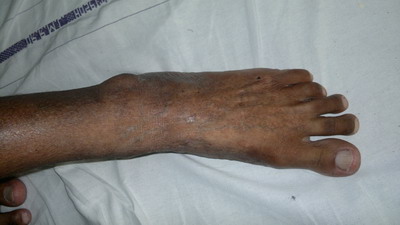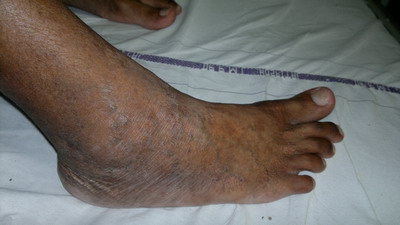|
|
Abstract
Introduction
Chronic venous insufficiency has been associated with the development
of venous stasis followed by dermatitis and later ulcer formation. It is
usually observed in heart failure, obesity, varicose veins, diabetes, blood
clots in the deep veins or post phlebitic syndrome.
Case presentation
Here we are reporting a previously unreported case of Obsessive Compulsive
Disorder (OCD) associated with venous dermatitis.
Conclusion
Many patients with OCD present initially to their physician. Because
of the frequency of nonspecific dermatitis in compulsive hand washers, as
well as the number of patients presenting with obsessions, dermatologists
should be familiar with this disorder which would lead to the early recognition
and diagnosis of OCD in turn increasing effective pharmacologic and behavioural
treatment strategies.
Introduction
With a lifetime prevalence rate of 0.5-3%, Obsessive Compulsive Disorder
(OCD) is commonly seen worldwide [1]. Obsessions
are anxiety causing thoughts, impulses, or images that are intrusive repetitive
and uncontrollable. Compulsions are repetitive behaviours (e.g., checking)
or mental acts (e.g., counting, reassuring) by which the person attempts
to control the anxiety. Behaviours causing distress for more than 1 hour
per day and significant disruption of normal functioning constitute OCD
[2]. Time-consumption in obsessions and
compulsions cause marked distress or functional impairment. People with
OCD have been hypothesized to be more affected by possibility-based information
leading to higher levels of doubt [3]. Besides
the commonly associated obsessions and compulsions mentioned above, OCD
is also found to be associated with various dermatological problems secondary
to underline pathology which often goes undiagnosed since very little is
being known about their associations.
The classic signs of venous disease are pitting edema, varicosities,
spider veins (telangiectasias), reticular veins (dilated bluish sub dermal
veins less than 3 mm in diameter) [4]. Venous,
or stasis, dermatitis is defined as erythema and scaling, most commonly
on lower limbs of those with chronic venous insufficiency [5].
It is seen in heart failure, obesity, varicose veins, diabetes, clots in
the deep veins, or post phlebitic syndrome [5].
The common mechanism causing venous stasis is venous hypertension due to
the valvular defect. As the deep veins valve becomes incompetent, when the
patients stand for a long time increased pressure is generated leading to
reflux of blood from deep to superficial venous system leading to stasis
[6]. This leads to an increase in the pressure
inside the leg veins, which damages the overlying skin likely due to leakage
of blood and blood products into the surrounding tissue causing inflammation
in the skin [6].
We here report a case of a patient who had obsessions of contamination
and compulsions of washing hands for hours in a day. This involved standing
for long hours which we propose secondarily led to venous insufficiency
leading to venous dermatitis in both lower limbs.
Case Report
A 22 year-old, Hindu unmarried male presented to psychiatry outpatient
clinic with a history of insidious onset continuous course illness of 12
years duration reporting of repetitive uncontrollable thoughts of contamination
of hands and doubt of something from his body falling as he walked. He would
recognize these thoughts to be of his own, but report of their senselessness
on few occasions only. He had to perform compulsive acts otherwise he would
feel distress. The compulsive acts included washing hands for hours after
going to toilet and every time after taking food. He would remain standing
during this period. The patient would keep looking backside while walking
in order to relieve the anxiety due to obsessions of doubt. He would also
pause for significant time in standing position checking if he had lost
anything from the pocket.
There was no other significant past, personal, or family history. Family
members tried to contact doctors but the patient would not go for treatment,
saying he was not ill and did not require any medical help. The patient
had stopped going for his job because of time taken in washing hands which
would be >8 hours a day and the patient reports of standing for this period
in bathroom every day since the last 6-7 years.
Mental status examination revealed anxious affect and obsession of contamination
and pathologic doubts. His Yale-Brown Obsessive Compulsive Scale score was
36 [7]. On physical examination varicose
veins, pitting edema, telangectasias and reticular veins were noted in both
the lower limbs predominantly around the ankles involving the feet (Figure
1). There were fan-shaped pattern of numerous small intradermal veins below
the maleoli. The area had scaly patches with pigmentation. The patient reported
that these changes have been present for few years and had been gradually
increasing from bottom to top. He also complained of bilateral aching leg
pain since 2 years.


A diagnosis of OCD with poor insight was made in accordance with Diagnostic
and Statistical Manual of Mental Disorders, Fourth Edition-Text Revised
[2]. Dermatology and Cardiology reference
was sought and the patient was diagnosed with venous dermatitis. Colour
Doppler of lower limbs showed incompetent perforators in the lower aspect
of left great saphenous vein and right short saphenous vein with competent
bilateral sapheno-femoral and sapheno-popliteal junctions. The insufficiency
of venous valves was proposed to have caused the dermatitis. The patient
was initiated on Tablet Fluoxetine 20mg/d and Exposure and Response prevention
therapy with which he reported improvement in OCD symptoms over two months.
Compressed stockings were advised for managing venous insufficiency with
slight improvement noted over two months.
Written informed consent was obtained from the patient for publication
of this case report and accompanying images.
Discussion
Psychodermatology describes an interaction between dermatology and psychiatry.
The incidence of psychiatric disorders among dermatological patients is
estimated at about 30 to 60% [8]. Prevalence
of OCD ranges between 2-3% in general population which might increase to
almost 14 to 25% in patients with skin problems [9].
Common skin disorders associated with OCD are some forms of dermatitis or
eczema, especially of the hand, as well as nail and cuticle picking or biting,
neurotic excoriations. These lesions usually occur due to scratching, pulling,
biting, picking, excessive hand washing and other self injurious behaviours.
Skin diseases and psychiatric illness may be interrelated in various
ways [10]. While dermatological disorders
may be generated or aggravated by psychological disorders (like in trichotillomania,
urticaria or icthyosis), dermatological disorders may result in few psychiatric
disorders (like in psoriasis or atopic dermatitis).
In the case described above, insufficiency of valves followed prolonged
standing for hours a day, since the last 6-7 years. Other causes were ruled
out. The patient reported of poor insight into his symptoms during the major
part of the illness which is a common cause for late presentation of patients
with OCD. A previous case report listed evidence of varicose veins in OCD
[11].
People with OCD may initially present to general physicians or dermatologists
for physical problems secondary to OCD. A study showed that 20% of patients
seeking treatment in a dermatology clinic had an OCD and secondary skin
problem [12]. Few studies have found almost
5 times more frequency of OCD in dermatological problems in comparison to
the general population [13]. In a study,
more than 45% patients with psychogenic excoriation presented to dermatology
were diagnosed with OCD [14]. A study concluded
most common obsessions were contamination in patients presenting to dermatology
clinics [15].
As reported that people with OCD frequently present to dermatology clinics
before going to a psychiatrist, our patient had also sought treatment for
discolouration of skin along with itching a few years back and was diagnosed
with eczema with no screening for OCD and the patient was never suggested
to visit a psychiatric facility which led to a persistence of physical symptoms.
Conclusion
The time of presentation of patients with OCD is long during which they
may suffer from secondary co-morbid illnesses. The people presenting with
venous dermatitis should be screened for cause of stasis so as to find any
causal obsessive compulsive pathology.
References
1. Degonda M, Wyss M, Angst J. The Zurich Study. XVIII.
Obsessive-compulsive disorders and syndromes in the general population.
Eur Arch Psychiatry Clin Neurosci. 243:16-22, 1993.
2. American Psychiatric Association. Diagnostic and Statistical
Manual of Mental Disorders. 4th ed. Washington, DC: American Psychiatric
Association, 1994.
3. Aardema F, O'Connor KP, Pélissier MC, Lavoie ME. The
quantification of doubt in obsessive-compulsive disorder. Int J Cogn Ther.
2(2):188-205, 2009.
4. Ross DS. Venous stasis ulcers: a review. Northeast Florida
Medicine 63(2):29-33, 2012.
5. Hess CT. Clinical Guide to Skin and Wound Care. 6th ed.
Philadelphia: Lippincott Williams & Wilkins; 2008.
6. Hjelmstedt A. Pressure decrease in the dorsal pedal veins
on walking in persons with and without thrombosis. A study of a fracture
series. Acta Chir Scand. 134:531-539, 1968.
7. Goodman WK, Price LH, Rasmussen SA, Mazure C, Fleischmann
RL, Hill CL, Heninger GR, Charney DS. The Yale-Brown Obsessive Compulsive
Scale: I. Development, use and reliability. Arch Gen Psychiatry. 46:1006-1011,
1989.
8. Korabel H, Dudek D, Jaworek A, Wojas-Pelc A. Psychodermatology:
Psychological and psychiatrical aspects of aspects of dermatology. Przegl
Lek. 65:244-248, 2008.
9. Jesitus J. Dermatologists must beware of skin-related
signs of OCD. Dermatology Times 2011, December 1.
10.
Kieć-Swierczyńska M, Dudek B, Krecisz B, Swierczyńska-Machura D, Dudek W, Garnczarek A, Turczyn K. The role of psychological factors and
psychiatric disorders in skin diseases. Med Pr. 57:551-555, 2006.
11. Aggarwal A, Jain M, Khandelwal A. Varicose Veins in
Obsessive-Compulsive Disorder Due to Pathologic Doubts. Prim psychiatry.
17(7):35-36, 2010.
12. Lamberg L. OCD Patients May Seek Help From Dermatologists.
Psychiatr News. 42:18-27, 2007.
13. Ebrahimi AA, Salehi M, Tafti AK. Obsessive-compulsive
disorder in dermatology outpatients. Int J Psychiatry Clin Pract. 11(3):218-221,
2007.
14.
Calikuşu C, Yücel B, Polat A, Baykal C. The relationship
between psychogenic excoriation and psychiatric disorders: a comparative
study. Turk Psikiyatri Derg. 13(4):282-289, 2002.
15. Demet MM, Deveci A, Taskin EO, Ermertcan AT, Yurtsever
F, Deniz F, Bayraktar D, Ozturkcan S. Obsessive-compulsive disorder in a
dermatology outpatient clinic. Gen Hosp Psychiatry. 27(6):426-430. 2005. © 2014 Egyptian Dermatology Online Journal
|


